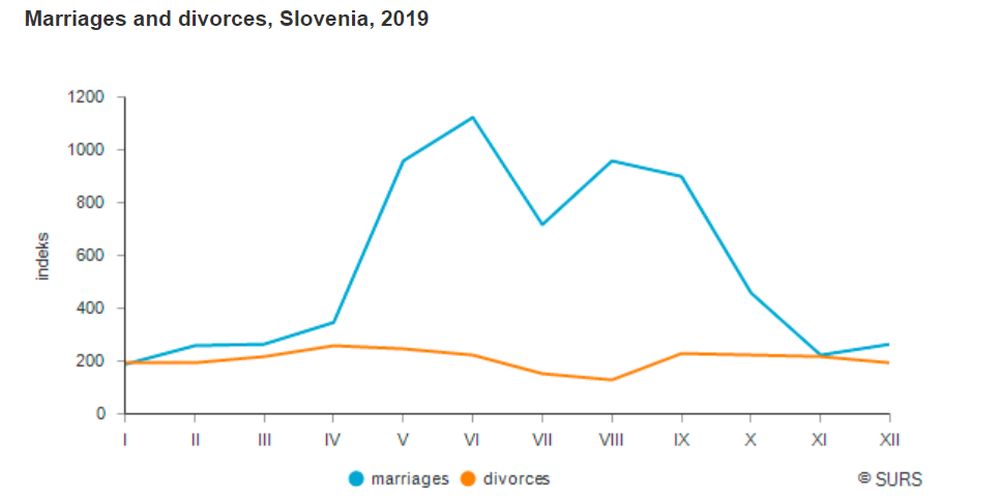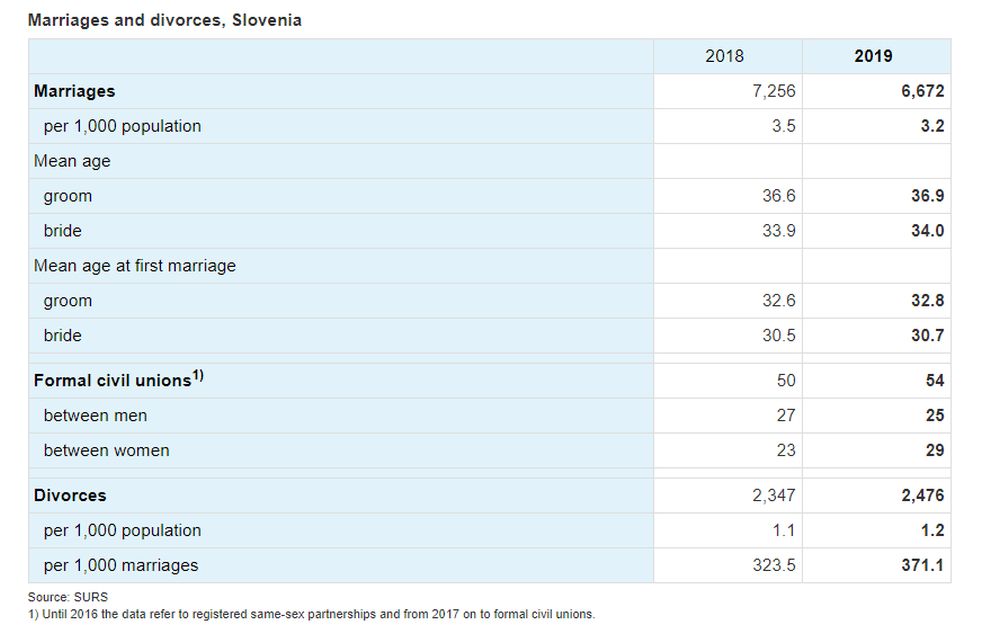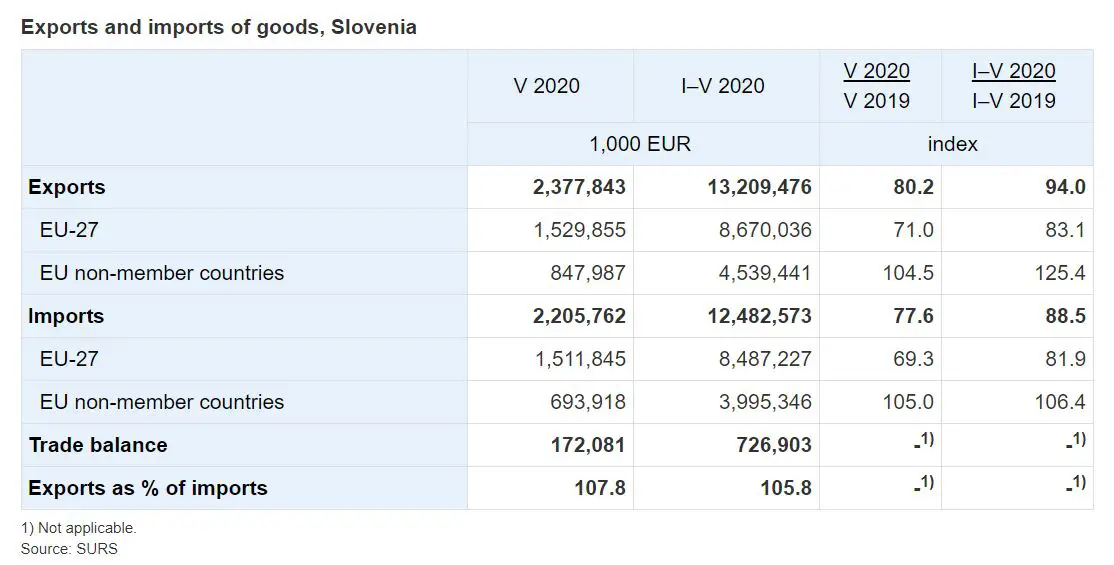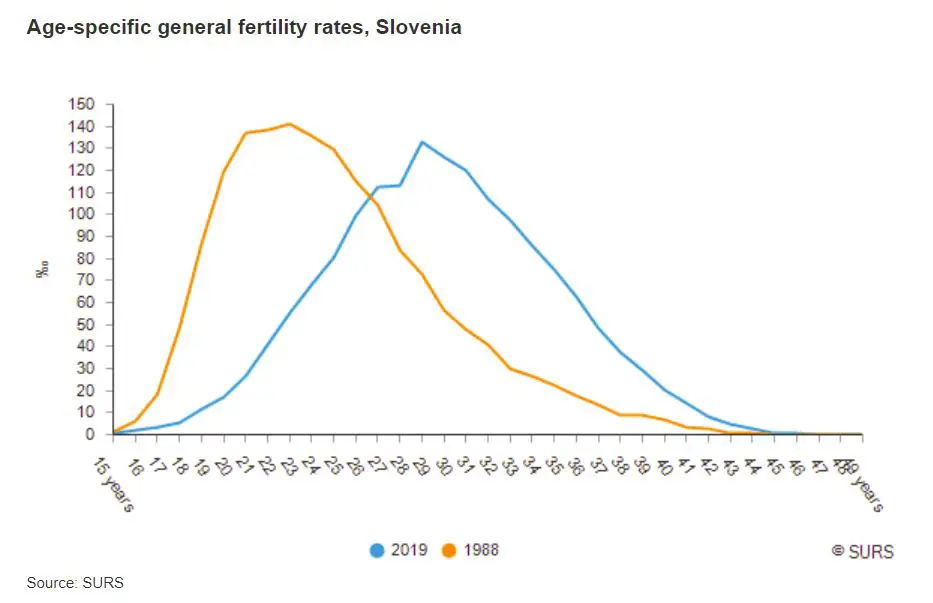Ljubljana related
STA, 31 August 2020 - Slovenia's economy has been hammered hard by the coronavirus pandemic and the ensuing lockdown with fresh data from the Statistics Office showing the country's output contracted by 13% in real terms in the second quarter compared with the same quarter a year ago. The second straight quarter of negative growth puts Slovenia in a technical recession.
Seasonally adjusted GDP decreased by 9.6% compared with the first quarter, and by 12.9% year-on-year. This means that the country's economy shrunk at an annual rate of 7.9% in the first half of the year.
Revised data from the Statistics Office show the seasonally-adjusted annual rate of decline in the first quarter, at the end of which Slovenia declared the epidemic and put public life on hold, was 3.7%, which compares to an earlier estimate of 3.4%.
The year-on-year contraction posted by Slovenia in the second quarter is somewhat lesser than the average for the eurozone and the EU running at -15.0% and -14.1%, respectively.
Fresh statistics show the country's shutdown imposed in mid-March had the biggest impact on domestic consumption, which slumped by 12% due to a 11.8% drop in final consumption expenditure and a 12.8% fall in gross capital formation.
Household final consumption expenditure slumped by 16.6%, of which 21.2% on the domestic market, with the highest decrease seen in consumption of fuels and services.
Gross fixed capital formation declined by 16.7% as construction investment decreased by 14.1% and investment in machinery and equipment slumped by 26.2%.
Due to a slump in external demand, exports fell by 24.5% compared with the second quarter of 2019; exports of goods decreased by 21.9% and exports of services fell by 35%.
Imports declined by 25%. Like in the case of exports, the slump in services was mainly observed in the travel industry.
The value added also declined, in particular in the hospitality sector, but the biggest negative impact was from manufacturing, said Romana Korenič from the Statistics Office.
Employment also fell in the second quarter, with the total of those in employment falling by 2% year-on-year to 1,023,200. Hit hardest were administrative and support services, manufacturing, and accommodation and food service activities.
On the upside, the situation started to improve in swathes of the economy the third quarter of the year, judging by macroeconomic data and survey among businesses and consumers.
Considering forecasts by domestic and international institutions, Slovenia's economy is not expected to contract by more than 8% this year, provided there are no new major shocks.
Signs of improvement were also noted by the Slovenian central bank in its response to the contraction in the output in the second quarter, which it said had been expectedly strong.
It said available data such as electricity consumption, tax revenue, the purchasing managers' index or business confidence suggest a considerable economic recovery in the summer.
As the coronavirus crisis set in, the central bank forecast a contraction of between 6% and 16% for the year depending on which of the three scenarios it had proposed would unfold.
"The current situation in the economy indicates the fall in the economic growth this year will be closer to the less adverse scenario, that is in accordance with our central forecast (of -6.5%)," said Banka Slovenije.
However, the central bank also noted that the situation is uncertain and that the recovery will largely depend on the development of the coronavirus pandemic and on how countries respond to a potential major outbreak.
"Due to the uncertainty, companies will keep postponing investment and households will remain cautiously frugal," a release from Banka Slovenije reads.
Similarly, IMAD, the government macroeconomic think-tank whose forecasts serve as a basis for state budgeting, said the contraction was within its expectations, with an improvement expected in the third quarter.
Noting that business sentiment and consumer confidence have been picking up since May, IMAD said they were still below the levels seen prior to the global coronavirus outbreak.
"In the third quarter we can expect a quarterly improvement or a lesser year-on-year decline in economic activity. With the presence of the virus and a new increase in infections in recent weeks, the situation remains uncertain, thus further fluctuation in economic activity is expected," commented IMAD director Maja Bednaš.
STA, 6 August 2020 - One in two 29-year-old Slovenians was living with their parents in 2018, whereas in 1991, the year Slovenia gained independence, only 20% of youths had such live-at-home arrangements. In 2018, most young people worked as service or sales workers, with some 80% of those aged 29 having a job.
At the beginning of 2020, there were some 310,000 youths in Slovenia, aged between 15 and 29, which compares to 430,000 in 1991, show the Statistics Office data released prior to International Youth Day, observed on 12 August.
According to recent projections, the number of youths will drop to the lowest level after 2080, when the figure is projected to stand at roughly 280,000. The downward trend will thus soften compared to the decrease seen among young population since independence.
When it comes to young people in Slovenia and their professions, two factors stood out in 2018: they seemed to be less interested in farming - the number of young farmers was down by 31% on the average, and a relatively small share of youths were managers or occupied top positions in the public administration compared to the average across all professions.
Out of the generation which was aged 22 in 2011, more than 90% remained in Slovenia seven years later. More than half of those who had emigrated were students in 2011. Most of the emigrants, aged 22 in 2011, live in Austria, Germany, Switzerland and Bosnia-Herzegovina now.
Taking a look at the financial position of those aged 29 in 2018, the data shows that the median annual gross income for those employed that year was near EUR 16,150, for the unemployed EUR 6,400, for students EUR 5,200 and for other inactive persons EUR 5,800.
The median annual gross income of 29-year-olds, including taxable and non-taxable income, in 2018 was EUR 14,800, which compares to EUR 15,700 for 34-year-olds. The median gross income for the 24-year-olds was meanwhile EUR 9,200. Fewer than half of those aged 24 in 2018 were employed.
29-year-old Slovenians with tertiary education exceeded the average income of those with secondary education by almost 30% in 2018.
International Youth Day was declared by the UN in 1999 to raise awareness about youth issues and stress the role young people have in society. The theme of 2020 International Youth Day focuses on the ways the young engage at local, national and global levels to contribute to institutional politics.
STA, 19 July 2020 - The financial position of Slovenian households keeps improving since assets growth continues to exceed debt. At the end of the first quarter in 2020, the surplus of assets over debt increased by EUR 2 billion year-on-year to EUR 41.9 billion, show central bank data.
At the end of the first quarter, Slovenia's households had assets of EUR 56.5 billion, up by EUR 2.5 billion year-on-year. Deposits increased by EUR 1.6 billion to EUR 22.9 billion, 90% of them were made at domestic banks and 72% of them were sight deposits.
In the same period, liabilities grew by EUR 427 million to EUR 14.6 billion. Loans, increasing by EUR 483 million, accounted for the bulk of the liabilities (EUR 12.9 billion) and were mostly arranged at banks (85%).
The finances of companies or non-financial corporations improved as well at the end of the first quarter. The deficit of assets over debt decreased by EUR 775 million year-on-year to EUR 38.9 billion.
Companies had assets of EUR 49 billion, a EUR 683 million increase year-on-year. Liabilities meanwhile stood at EUR 87.9 billion.
STA, 15 July 2020 - The average gross earnings in May amounted to EUR 1,892.31, down by 2.3% on April nominally and by 3.2% in real terms. The average net wage was EUR 1,244.44, a 1.7% and 2.6% decrease respectively on April, show data released by the Statistics Office on Wednesday.
Year-on-year, average gross earnings increased, in nominal terms by 9.5% and in real terms by 10.8%. The increase was largely the result of temporary stimulus measures related to the Covid-19 epidemic, which were also in place in April.
Compared to April, average gross earnings in May decreased in both sectors, in the private sector by 2.5% and in the public sector by 2.2%. In the institutional sector general government they decreased by 1.9%.
The highest average gross earnings for May were paid in electricity, gas, steam and air conditioning supply (EUR 2,589.33).
Compared to gross earnings for April, average gross earnings for May increased the most in public administration and defence, compulsory social security (by 7.0%) and decreased the most in accommodation and food service activities (by 8.0%).
If average gross earnings for May were calculated by the number of persons in paid employment on the basis of paid hours and not on the basis of the number of persons in paid employment, they would be higher than gross earnings for April in public administration and defence, compulsory social security by 4.8% and in accommodation and food service activities by 1.0%.
More detailed data can be found here
STA, 10 July 2020 - Slovenia's exports decreased by 6% to EUR 13.2 billion in first five months of the year, while imports fell by 11.5% to EUR 12.5 billion, show Statistics Office data released on Friday. In May, exports were down by 19.8% year-on-year to EUR 2.38 billion and imports by 22.4% to EUR 2.21 billion for an export to import ratio of 107.8%.
Slovenia recorded an external trade surplus in all of the first five months of 2020, the surplus in all five months combined amounting to EUR 726.9 million. In this period, the export to import ratio was 105.8%.
As for May, the office noted that the year-on-year decrease was smaller than in April, when exports were down 28.8% year-on-year and imports by 41.2%.
It said the negative effect of the epidemic on external trade in goods had been reduced somewhat, while adding the significant annual decline in April was also due to exceptionally high value of imports in April last year.
In May the export to import ratio was 107.8%; a surplus of EUR 172.1 million was generated in external trade in goods. The May external trade surplus is the second highest this year and the highest of the four May surpluses recorded after 2010.
Exports to EU member states in May amounted to EUR 1.53 billion (down 29.0% year-on-year) and imports to EUR 1.51 billion (30.7% less).
"Trade with this group of countries grew continuously from October 2016 until the second half of last year, when the effects of economic cooling began to show. The epidemic negatively affected trade with the EU already in March 2020 and even more in April and May," the Statistics Office wrote.
As for trade with countries outside the EU, Slovenia exported goods worth EUR 848 million in May (up 4.5% y/y) and imported goods worth EUR 693.9 million (up 5.0%).
"Since the end of 2018, we have been recording high growth rates of trade with this group of countries, the trend continued in May, however the growth was significantly reduced by the epidemic."
More on this data can be found here
STA, 26 June 2020 - The National Institute for Public Health (NIJZ) has highlighted on the occasion of International Day against Drug Abuse the problem of widespread cannabis use among Slovenian adolescents. An international study places Slovenia among the countries with the highest shares of 15-year-olds using cannabis.
The institute pointed to the 2018 HBSC (Health Behaviour in School-Aged Children WHO collaborative cross-national survey) report that showed an average of 13% of 15-year-olds in the 45 participating countries have already used cannabis. The share for Slovenia is 21%, which ranks the country 7th, the NIJZ said.
Related: Talking with the Slovenian Cannabis Social Club (SKSK) About Its Aims & Achievements
Slovenia fares even worse when it comes to 15-year-olds who have used cannabis in the 30 days before being quizzed for the survey. The international average is 7%, while it is 13% in Slovenia, which places the country only behind Canada and Bulgaria.
The NIJZ listed relative ease of access as one of the reasons for widespread use of cannabis among Slovenian youngsters. The survey has half of the 15-year-old Slovenian respondents assessing they could obtain cannabis easily or very easily within 24 hours.
Related: Learn Slovenian With Cannabis
The institute stressed the importance of preventive activities, such as equipping young people with proper social, emotional and behavioural skills, and measures aimed at reducing access to drugs, while stressing the use of cannabis among young people is harmful for brain development.
"Research has shown that with children and youngsters cannabinoids affect the development of the part of the brain responsible for the processing of received information and for thought processes helping solve problems and taking decisions. With regular use, these capacities are reduced, especially for those who start using this drug before the age of 18," Ada Hočevar Grom of the NIJZ warned.
Moreover, some research links the use of cannabis to poorer school performance and to the increased risk of the abuse of other drugs and addiction.
STA, 23 June 2020 - A total of 19,328 children were born in Slovenia in 2019, 1.3% fewer then the year before, but the birth rate remained at 1.61. The number of deaths, at 20,588, exceeded the number of births for the third year running, show data released on Tuesday by the Statistics Office.
This is the second year in a row that fewer than 20,000 children were born in Slovenia after the figure had been exceeded for ten consecutive years prior to 2018.
At 9,977, the number of boys born fell short of 10,000 for the first time in 12 years. The number for girls, already below 10,000 in 2016, was 9,351.
One of the reasons for the declining number of births in recent years lies in an increasing number of women putting off the decision to have their first child. The average age increased again last year, to 29.6 from 29.5, while this compares to 23 three decades ago.
This also pushes up the average age of the mothers of newborns in general - it was 31.1 last year, while it stood at 25.9 in 1989.
Another reason is the decline in the birth rate seen in the 1980s and 1990s, which has led to a lower number of women aged between 25 and 34 at present.
Meanwhile, the parents of 57.7% of the 2019 newborns were not married. 16,175 children were born to parents who both had Slovenian citizenship and 1,339 to parents neither of whom had Slovenian citizenship.
Luka was the favourite name picked for boys for the 21st year running, being given to 2.8% of the newborns, while Zala made it back to the top among girls with 2.9%.
Meanwhile, the number of the deaths increased by 0.5% compared to 2018. The average age of the deceased exceeded 78 for the first time last year, reaching 78.1. It was 73.9 for men and 82.1 for women. In the last decade, the average for men increased by 3.8 years and for women by three years.
According to the Statistics Office, boys born last year can expect to live until they are 78.5, while the life expectancy for girls is 84.2. In the last ten years, the figures have increased by 9.1 and 7.1 years, respectively.
The share of so called premature deaths, meaning before the age of 65, was 16% last year - 22.4% among men and 9.8% among women. The gap between men and women in this category has been shrinking in the last decade. In 2009 the share for men was 30.8% and for women 12.4%.
The infant mortality rate last year was 2.1 deaths per 1,000 live births. The rate has been decreasing in Slovenia in the last decade and is among the lowest among EU member states.
More stories on demographics in Slovenia, while you can see more on births in Slovenia in 2019 here
STA, 25 June 2020 - Slovenia's population is ageing, while the number of residents is increasing on the back of immigration, show data for the 1991-2020 period published by the Statistics Office to mark Statehood Day. The state of the Slovenian economy is improving since the country declared independence, as are connections with foreign markets.
Marking Statehood Day on 25 June, the day in 1991 when Slovenia declared independence from Yugoslavia, the Statistics Office said that on 1 January 2020, Slovenia had 2,095,861 residents or 15,000 more year-on-year.
There were 1,051,066 men and 1,044,79 women, with men outnumbering women primarily because of the growing number of immigrants, who are mostly men.
Slovenia's population has been increasing in the last 25 years, as has its average age. At the beginning of 2019, the average age of a Slovenian resident was 43.4, which is two years more than ten years ago. A fifth of Slovenians are aged 65 or older.
Following the declaration of independence, Slovenia's economy experienced a blow as it lost the ex-Yugoslav market, introduced market economy and faced a high inflation rate. It was almost 250% in 1991, and it took four years to drop below 10%.
In 1991, Slovenia's gross domestic product (GDP) dropped in real terms by 8.9%, and by a further 5.5% in 1992. After a longer and relatively stable period, it was down by 7.8% in 2009 at the peak of the global economic and financial crisis.
Up until this spring, the Slovenian economy was recovering at an annual pace of between 3% and 5%. In the first quarter of 2020, the country's GDP was meanwhile down by 2.3% compared to the same quarter last year.
In the first quarter of the year, the very end of which was also marked by the coronavirus epidemic, foreign and domestic demand was also down.
In terms of GDP per capita, Slovenia placed 16th last year among the 28 EU member states.
Germany has remained Slovenia's most important trade partner all these years, while within the EU, Slovenia's trade with Austria increased the most. Outside the EU, Slovenia has exported most of its goods to the countries of the former Yugoslavia and to China.
In the 1991-2020 period, the Statistics Office recorded the highest unemployment rate in the first quarter of 2011, at 11.1%, while the lowest rate, at 4%, was recorded in the last quarter of 2019, when only 41,000 persons were unemployed.
The number of tourists visiting Slovenia has been mostly increasing since 1991, reaching a record 6.2 million last year. The figures are expected to be much lower this year as tourism was ground to a halt in mid-March and is still recovering.
You can see more on these statistics here
STA, 21 June 2020 - Slovenia still lags behind the EU-27 average in actual individual consumption per capita and in GDP per capita, which reached 81% and 88% of the 2019 average, respectively, the EU's early figures, released by Slovenia's Statistics Office (SURS), show.
SURS released Eurostat's preliminary figures for 37 European countries, showing that actual individual consumption per capita - an indicator of material prosperity of households - ranged from 59% to 135% of the EU average.
Slovenia's actual individual consumption in 2019 was two percentage points above the country's 2018 figure.
Closest to Slovenia in actual individual consumption was Malta (80% of the EU average), and Poland and Romania (both 79%).
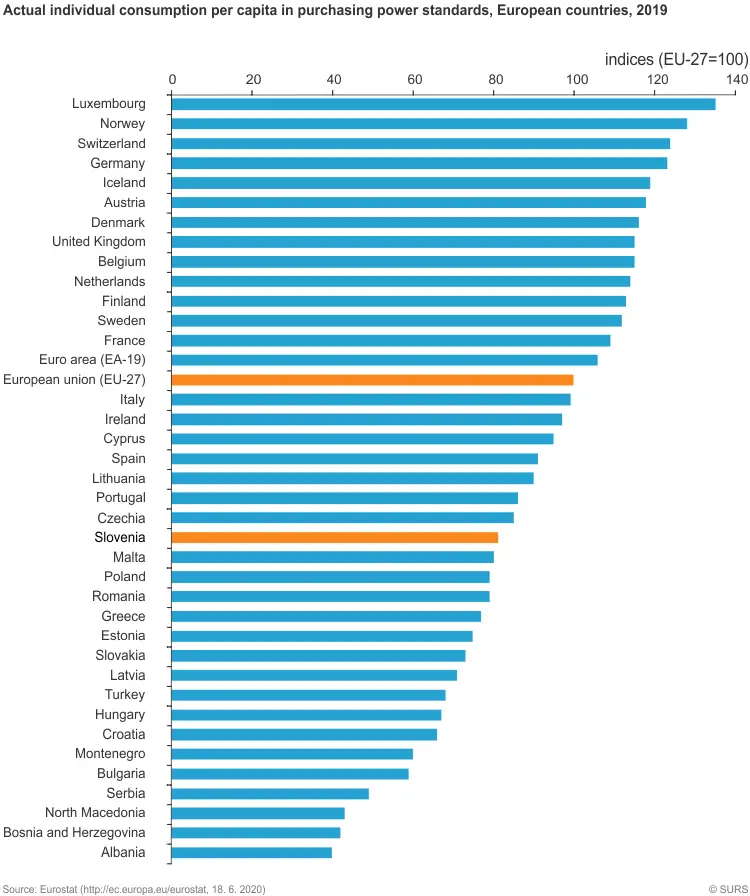
The differences among the 37 European countries were even bigger in GDP per capita, an indicator of economic activity, which ranged from 53% to 261% of the EU average.
GDP per capita in Slovenia has been rising, up one point in 2019 over 2018, in what was the fourth consecutive annual rise. Closes on the list to Slovenia last year were Cyprus with 89% and Spain 91%.
Luxembourg fared best in both indicators, which are expressed in purchasing power standards, and Albania worst.
Actual individual consumption and Gross domestic product per capita in purchasing power standards, volume indices, European countries (EU-27=100), 2019
| Country | Actual individual consumption per capita | Gross domestic product per capita |
| European union (EU-27) | 100 | 100 |
| Euro area (EA-19) | 106 | 106 |
| EU-27 | ||
| Luxembourg | 135 | 261 |
| Germany | 123 | 121 |
| Austria | 118 | 127 |
| Denmark | 116 | 129 |
| Belgium | 115 | 117 |
| Netherlands | 114 | 128 |
| Finland | 113 | 111 |
| Sweden | 112 | 120 |
| France | 109 | 106 |
| Italy | 99 | 95 |
| Ireland | 97 | 191 |
| Cyprus | 95 | 89 |
| Spain | 91 | 91 |
| Lithuania | 90 | 82 |
| Portugal | 86 | 79 |
| Czechia | 85 | 92 |
| Slovenia | 81 | 88 |
| Malta | 80 | 99 |
| Poland | 79 | 73 |
| Romania | 79 | 69 |
| Greece | 77 | 68 |
| Estonia | 75 | 84 |
| Slovakia | 73 | 74 |
| Latvia | 71 | 69 |
| Hungary | 67 | 73 |
| Croatia | 66 | 65 |
| Bulgaria | 59 | 53 |
| United Kingdom | 115 | 105 |
| EFTA Member states | ||
| Norway | 128 | 144 |
| Switzerland | 124 | 153 |
| Iceland | 119 | 130 |
| Candidate countries for EU | ||
| Turkey | 68 | 61 |
| Montenegro | 60 | 50 |
| Serbia | 49 | 41 |
| North Macedonia | 43 | 38 |
| Albania | 40 | 31 |
| Potential candidate country for EU | ||
| Bosnia and Herzegovina | 42 | 32 |
There were 6,672 marriages and 2,476 divorces registered in Slovenia in 2019 according to the newest report by the Statistics Office (SURS). The number of marriages fell 8% compared to 2018, while divorces rose 5.5%. There were also 54 same-sex marriages registered in 2019.
Grooms were on average 36.9 years old at the time of marriage and almost three years older than brides were, with the latter on average 34.0 years old in 2019.
Most marriages were made between citizens of the Republic of Slovenia (80.8%). In 583 of the newly wed couples (8.7% of all marriages), the groom was a citizen of the Republic of Slovenia and the bride a citizen of another country, most often Bosnia and Herzegovina. In 514 marriages (or 7.7% of the total), the bride was a citizen of the Republic of Slovenia and the groom from another country, again most commonly of Bosnia and Herzegovina. In 185 marriages (2.8%), both the groom and the bride were foreign citizens.
In 2019, 2,476 couples divorced, or 129 (5.5%) more than in 2018. The average age of the newly divorced men was 46.8 years, and that of divorced women 43.9 years. The marriages of these couples lasted on average 14.3 years until the divorce, although 40 couples divorced in the first year of marriage.
In 1,261 divorces (50.9%) the couples had no dependent minor children, while in the remaining 1,215 (or 49.1%) divorces there were a total of 1,980 dependent minor children who were also part of the divorce procedures. The majority of these children, 67.9%, were assigned to their mothers, 5.3% of children were assigned to their fathers and 24.3% to both parents.
People who divorced in 2019 were mostly citizens of the Republic of Slovenia (83.5%). In 162 divorces (or 6.5%), the husband was a citizen of the Republic of Slovenia and the wife a citizen of another country. In 211 divorces (or 8.5%), the wife was a citizen of the Republic of Slovenia and the divorced husband from another country. In 35 divorces (or 1.4%), both divorced spouses were foreign nationals.
